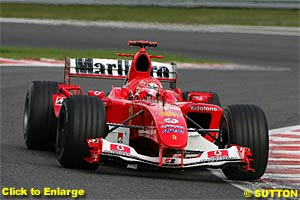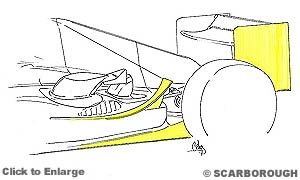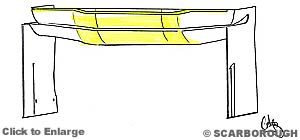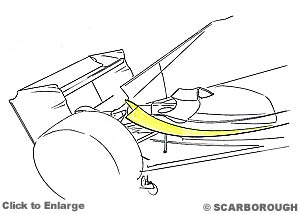
Atlas F1 Technical Writer
The Spa-Francorchamps circuit is rightly famous among Formula One fans, and offers a massive challenge to the teams' aerodynamicists, tyre suppliers and race engineers. Atlas F1's Craig Scarborough reviews the cars and technical challenges that arose in an action packed Belgian Grand Prix
In the hills and forests of Belgium, the Spa-Francorchamps circuit winds up and down through fast and slow curves to present the greatest challenge to the drivers, and for the teams the requirements in setting up the car also provides a challenge. The cars require mechanical grip for the slow corners, such as the hairpin at La Source, aerodynamic efficiency for the frighteningly fast Pouhon, and the compliance and poise to take Eau Rouge flat out.
As a result of the high speed sections the teams are obliged to run only medium downforce, while the mechanical grip comes from softened suspension with the longest wheel travel for any circuit. The car is loaded with aerodynamic forces, unloaded by centrifugal force as the cars crest the hills, and compressed once more as the car bottoms out through Eau Rouge. This also necessitate higher ground clearance to preserve the plank and skid block from illegal amounts of wear; this in turn reduces the efficiency of the diffuser and front wing, so more downforce has to be recovered by winding on more wing angle.
Yes with all this careful setting up the teams then had to contend with wet practice sessions and a race predicted to be wet (which actually turned out to be completely dry). Changes required for a wet set up can be both similar and opposite to a good Spa dry set up - the softening of the suspension and raising of the ride height (the latter to prevent the floor aqua planning) while softening the power delivery, adding of downforce and closing off cooling outlets go against the ideal set up.
In the race the grid was mixed up by the compromised set ups; a wet and dry qualifying session and the circuits overtaking opportunities provided a spectacular race, but left a massive repair bill for the teams, with several of them losing both cars to major accidents. Some of these accidents were directly related to Michelin tyre failures; this initially appeared to match the issues at the Indianapolis race, as high speeds and a lot of debris punished the tyres, resulting in the right rear tyre ripping open on the outer shoulder of the tyre. The final conclusion reached by Michelin's technicians did in fact lay the blame on sharp edges to the kerbs in the reshaped Bus Stop chicane, which also accounted for Ryan Briscoe's major accident on Friday.
With the recent influx of new parts the Belgian race saw many teams retrieve wing sets used at similar previous races. Many teams referenced the Montreal set up as the base for this weekend's race, albeit with a lot more angle added to the flaps to raise the downforce level. With the very low settings used at the more open Canadian circuit, most teams featured the complex shaped rear wings to reduce drag while providing the correct level of downforce.
Hungary featured a new rear wing deflection test, introduced after fears regarding the old test which pulled the wing by its endplates backwards, introduced in 1999 to prevent teams using flexible lower wing mounts to deflect at high speed to reduce drag. The new test now places the load directly on the rear flap to ensure neither the lower mount or the flap itself can be deflected at high speed.
Team by Team
Ferrari
Friday saw the team complete the usual programme of set up and tyre evaluation, with the red flag for Ryan Briscoe's accident allowing the team more time to work on the car, although Michael Schumacher did have a spin and trip through the gravel from which he was able to recover to the pits. After losing much of the free practice sessions, the team topped the times in the Q1 session, but the return of rain in the Q2 session saw Rubens Barrichello miss his braking for the Bus Stop, and Schumacher's better lap was in wetter conditions than the Renault of Jarno Trulli.
Poor starts lost both drivers several places in the race, with Barrichello involved in an opening lap shunt resulting in one stop for a puncture and one to replace the damaged rear wing; as these were completed under the safety car the lost time was minimal, and his run through to an eventual third position proved the decision to repair the car was correct. Schumacher also lost out with a heavy fuel load in the opening laps and at each restart; the later safety car periods saw Schumacher being forced to trail around at low speed to the detriment of his tyre temperatures, while Raikkonen's Michelins actually recovered at this lower pace.
Williams
The opening was a conventional programme with Antonio Pizzonia finding more speed than Juan Pablo Montoya in both sessions; in the shortened Saturday free practice session Pizzonia undid his hard work with a spin into the tyre barriers at Rivage, causing a red flag to close the session. In Q1 his lap was slower than Montoya's by some margin, and in Q2 Montoya still outshone Pizzonia despite Montoya using the wrong tyres for the conditions.
Hopes were raised in the race when Montoya got a perfect start and both cars were on the pace and fighting for positions; Montoya overtook Schumacher on the outside exit of the Bus Stop, although a repeat of this move on Trulli did not come off and started the teams decline. In the middle safety car period Pizzonia's car lost all its gears and ground to a halt on the track, and late in the race Montoya's rear tyre failed, damaging the wing and suspension as it flailed around, forcing his retirement.
McLaren
Again running the narrow nose and featuring the revised bargeboards run in Hungary, the MP4-19B still mounts its forward pair of bargeboard to the twin keels, but these now curve back in and under the nose, finally creating an outward step near floor level. In addition to the revised frontal profile, the boards sported horizontal plates around the front suspension to control the up-wash from the wing. The resulting set up is similar in concept to Ferrari's two part bargeboards, although McLaren still run a smaller third intermediate board between the other pair.
In the race good starts put the drivers into contention with the leaders, with first Raikkonen and then Coulthard being able to pass Schumacher in their pursuit of the lead. Before his first stop Coulthard had a puncture and lost time with a long run back to the pits. His race would further deteriorate when he hit the rear of Christian Klien's Jaguar, knocking his front wing off and sending his bargeboard over his head and lodging in front of the rear wing; the car was repaired and deemed safe enough to return the race for the closing laps to finish in seventh.
Meanwhile Raikkonen enjoyed a competitive race, only troubled by gear selection problems in the middle stint, which lost him time to the chasing Schumacher. His lead during the later safety car periods allowed Raikkonen to control the pace and he toyed with Schumacher, running very slow and leaving it until the last minute to bolt and make a small gap while the Bridgestones recovered.
Renault
After identifying that the failure to Trulli's race engine in Hungary was no more than a failed O ring between the engine and pump, the D spec engine was brought to Spa. The balance of the car was similar to previous medium downforce races, with the added novelty of a stepped gurney on the rear wing. Gurneys are often used as a method of pulling air faster from under the wing, in order to prevent the separation of airflow under the wing, creating drag.
After poor performances due to inconsistent handling on Friday, Saturday saw the cars pace improve in the shortened practice sessions and Q1. In Q2 a lull in the rain allowed the team to risk intermediate tyres and resulted in a pair of top times, finally only being split by Schumacher's Ferrari.
In the race the team's usual amazing starts pressed them into the lead, being only pressured by Raikkonen's car. After his first stop Trulli's car changed and provided no rear end grip, leaving him struggling all the way to the end of the race; the team will prepare a new chassis for him in an attempt to explain the problem. Meanwhile Fernando Alonso was leading until an engine failure spewed oil on to the rear of the car, forcing him into two spins and retirement.
BAR
BAR were one of the teams to struggle with the new, more rigorous rear wing flex test. In fact the wing set used at Spa did not feature the complex shapes used by many other teams, although the two facts may not be related. As with Williams, BAR deleted the vertical section of the flip ups between the rear wheels for Spa.
This problem was not comparable to the ill fortunes the drivers received in the race; on lap one both drivers were involved in incidents, forcing Takuma Sato to retire after hitting Mark Webber and Jenson Button to pit for a new nose after a coming together with both Felipe Massa and Pizzonia. Button was able to rejoin the race, and made good progress until his rear Michelin also failed at high speed, spearing the car into the Minardi he was lapping and immediate retirement.
Sauber
Only detail changes to the car, and Montreal spec wings, were introduced by Sauber for Spa. Positive comments were forthcoming from both drivers on Friday; this optimism rewarded Giancarlo Fisichella, who got the better lap in qualifying to post fifth, with Massa following in eighth.
After poor starts against the cars behind them both Saubers were involved in first lap incidents, causing damaged bodywork and wings for both cars; Massa had his rear wing replaced and suffered ongoing steering vibrations, while Fisichella, with damage to his diffuser, had to soldier on, especially at the restarts as the Bridgestones were overcooling and less grippy to defend their positions at the restarts. In the end a two car finish in fourth and fifth was quite some reward for the team.
Jaguar
Jaguar brought some small revisions to the car and changes to the Cosworth engine to Belgium. No problems were reported for the three cars running on Friday, while accurate tyre choice in qualifying allowed the drivers to reflect the pace possible for the rain falling during their laps. At the first lap Webber tried to make up ground over an already excellent start and found himself hitting the rear of Barrichello, losing his front wing and then his steering through Eau Rouge, triggering a shunt involving several other cars. He was out on the spot, but teammate Klien picked his way through the debris and, despite being hit in the latter stage by Coulthard's McLaren, finished in sixth place.
Toyota
No visible changes were detected on the Toyota for this race. A bad weekend started as on Friday's second session when Ryan Briscoe had major shunt at Eau Rouge and wrecked his car, fortunately without injury to himself. In first qualifying Ricardo Zonta spun on the painted kerbs and hit the barrier, damaging the car.
The major parts were replaced for his qualifying lap, but many parts could not be replaced in time for his second lap; a long list of aero and mechanical parts had to be replaced in Parc Ferme. At the start Olivier Panis was involved in the incidents and had to pit for a new nose; meanwhile Zonta was far enough back to pick through the melee and raced well up until lap 40 when his engine failed, the first for Toyota all season. Panis brought his car home for one point, which was some reward for the team.
Jordan
Jordan arrived at Spa with an unchanged car, still sporting the shoulder wings from Hungary. Friday went cleanly, with only a spin at the hairpin for Giorgio Pantano and a small oil leak for Nick Heidfeld, although all three drivers complained of a lack of grip and a poor set up. Things improved for the drivers in the shortened Saturday morning session, and Pantano topped Heidfeld in Q1, but running early in Q2 meant both drivers were obliged to run extreme wet tyres following the showers, and cost them over 3 seconds per lap from Q1.
In the race both drivers were involved in the first lap shunts, with Pantano retiring immediately and Heidfeld pitting once for a new nose cone and then a string of unscheduled stops to fix an engine problem. His pace was also restricted from damaged bargeboards caused on the first lap, but none the less he finished the race, albeit well down in eleventh place.
Minardi
With Zsolt Baumgartner beating the Jordan on Friday Minardi looked to have a promising weekend ahead of them. But Gianmaria Bruni's shunt, which red flagged the only morning session on Saturday, pushed the team back, and by qualifying only drivers with disastrous laps were behind the Minardis. In the race the multiple accidents through Eau Rouge saw Baumgartner knock Bruni into the barrier, before Baumgartner himself was struck by Button's punctured BAR, forcing his retirement.
After a year's break due to legal issues Spa has returned to the F1 calendar. One of the true classic circuits, Spa provides some serious challenges for engineers and drivers alike. This year the weekend was mixed up, with both dry and wet weather over the opening two days leaving the drivers only semi-prepared for a bright sunny race day.
 With the Constructor's Championship tied up, and the driver's crown out of the reach of other teams, Ferrari opted for a conservative weekend, and appeared with no new parts on show. The team used the longer rear torsion bars which protrude through the fairing over the gearbox, and they also erred on the side of caution by adopting only one chimney on the right hand sidepods to safeguard oil temperatures.
With the Constructor's Championship tied up, and the driver's crown out of the reach of other teams, Ferrari opted for a conservative weekend, and appeared with no new parts on show. The team used the longer rear torsion bars which protrude through the fairing over the gearbox, and they also erred on the side of caution by adopting only one chimney on the right hand sidepods to safeguard oil temperatures.
 Williams again appeared with the new conventional nose, albeit with differing profiles to the trailing edge of the front wing flap, but made some changes to the rear of the car. The flip ups, which have been increasingly complex on the Williams, have been simplified, with the floor level flip up being deleted for the time since March, and the main flip ups no longer folding to form a vertical surface between the rear wheels. Finally, the rear wing endplate was devoid of the gills and slots from previous races.
Williams again appeared with the new conventional nose, albeit with differing profiles to the trailing edge of the front wing flap, but made some changes to the rear of the car. The flip ups, which have been increasingly complex on the Williams, have been simplified, with the floor level flip up being deleted for the time since March, and the main flip ups no longer folding to form a vertical surface between the rear wheels. Finally, the rear wing endplate was devoid of the gills and slots from previous races.
 Friday went smoothly for the team, with Kimi Raikkonen topping the second session times and David Coulthard less happy down in sixth. Qualifying reversed their fortunes, with Raikkonen running in the later (and wetter) laps leaving Coulthard to post fourth in the drier spell.
Friday went smoothly for the team, with Kimi Raikkonen topping the second session times and David Coulthard less happy down in sixth. Qualifying reversed their fortunes, with Raikkonen running in the later (and wetter) laps leaving Coulthard to post fourth in the drier spell.
 As Renault's wing uses such different profiles across its span the gurney needs to be more effective over the steeper middle section; a larger gurney cannot be fitted, so the team have effectively moved the gurney strip down the underside of the wing to create its effect earlier.
As Renault's wing uses such different profiles across its span the gurney needs to be more effective over the steeper middle section; a larger gurney cannot be fitted, so the team have effectively moved the gurney strip down the underside of the wing to create its effect earlier.
 Friday saw only an oil leak to the third car's engine, which would not affect the race drivers' grid positions. In qualifying the choice to run extreme wet tyres was not rewarded by the actual wet conditions, leaving the heavily treaded tyres to overheat and ruin both drivers' laps.
Friday saw only an oil leak to the third car's engine, which would not affect the race drivers' grid positions. In qualifying the choice to run extreme wet tyres was not rewarded by the actual wet conditions, leaving the heavily treaded tyres to overheat and ruin both drivers' laps.
|
Contact the Author Contact the Editor |
Please Contact Us for permission to republish this or any other material from Atlas F1.
|
Volume 10, Issue 35
Atlas F1 Exclusive
Summer of Sam
Bjorn Wirdheim: Going Places
Ann Bradshaw: Point of View
2004 Belgian GP Review
2004 Belgian GP Review
Technical Review: Belgium 2004
The Drought Breaks
Stats Center
Qualifying Differentials
SuperStats
Charts Center
Columns
The F1 Insider
Season Strokes
On the Road
Elsewhere in Racing
The Weekly Grapevine
> Homepage |